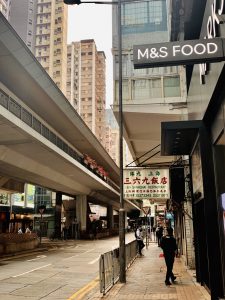9413, DIR. Francis Ng Chun Yu (1998)
JUNCTION OF HENNESSY ROAD AND EAST QUEEN ROAD, Wan Chai, Hong Kong

Smash-head and Carmen met at the junction of Hennessy Road and East Queen Road. Scenes from 9413 (1998), directed by Francis Ng.
‘Smash-head’, the male protagonist, is a policeman in the movie ‘9413’. He got this nickname for his abnormal behaviors, not as an earnest cop to maintain public security, but as an insane, extreme ‘environmentalist’, who would push a harmless passer-by into the sea only because the poor victim was eating instant noodles from a plastic bowl. However, ‘environmentalist’ can’t define smash-head since the man is more an environmentalist about his mind, his spirituality, who desperately longs for something lost back. In this city built upon landfill, on ruins and contaminant, and on disappearance, he lost his unpolluted goodwill once he had as a young man who joined the police simply for the aspiration to become a rescuer instead of an onlooker after witnessing a girl drowning. The bureaucracy, the dark side of the police office, as well as the death of his virtuous partner Fatty Cheun deprived him of the trust towards people, the system, the city and himself. The junction of East Queen Road and Hennessy Road, where Smash-head re-found the female protagonist Carmen, is the place for him to let go of his guard and construct trust relationship with people again.
The surroundings have changed slightly over twenty years, including the crossing, the signal lamps, the guide board directing to Supreme Court Road, and the pedestrian bridge over head. In the film, Carmen is a psychotherapist who symbolizes illumination, shelter and serenity to Smash-head. Once rejecting her to offer help due to lack of trust, smash-head attempted to have a second try, to trust her by confirming she also trusts him back. He asked her to close her eyes, letting him be her eyes to cross the Hennessy Road, which is actually a hazardous jaywalking, a typical ‘smash-head’ action. The actual place hardly has any indicator of danger or disturbance if you don’t walk inside the traffic flow. In the reality, in daylight, shadow is scarce, and everything is in order, the pedestrians, the vehicles, the conscientious signal lights, the footbridge carrying people from one side of Hennessy Road to another side of it without intervening in the traffic. Whereas in the film, the unusual action of characters adds another layer to the ordinary scene of this place, as they threaded through the car current, embraced by sound of vehicles hurtling, honking and braking at their fingertips.
Hennessy Road is wide, spacious, well-planned, thus perfect for fabricating a reversed impression to reveal the unusualness, void, and suppressed anxiety and insecurity underneath normal city scenes. The jaywalking stirs up wrinkles over the undisturbed surface of ordinary urban life like throwing a pebble into a pond. The fact that the film selects this place to accommodate the happening of an experiment of trust seems to impose a challenge onto the plausibly safe, convenient and orderly city environment. The city may be a shelter to citizens’ body sometimes, but seldom a shelter to their hearts, which weather a lot in the harsh rain, merciless sunburn and violent wind of the ever altering and accelerating city life. In the opening of the film, Carmen questioned to all Hong Kong people, why they are so obsessed with speed, with artificial convenience, with MTR, too ignorant to take a careful look at the exquisite natural scenery of Hong Kong, the embracing sea, enclosing mountains, and azure sky. Maybe every one of us needs to cross our own ‘Hennessy Road’ to recover the trust towards others and the city.
— Shen Ao 3035637424
Junction of Hennessy Road and East Queen Road
Junction of Hennessy Road and East Queen Road, narrated.
Hennessy Road view, HSBC branch, narrated.
Wan Chai street view, Hung Shing Temple, narrated.

A close-up look at Hung Shing Temple, Wan Chai.

- The Shanghai Three Six Nine Restaurant, new location different from the one passed by Smash-head in the film.
I enjoy the narrated videos of your field work which could have benefited even more if you had closer visual comparison with movie stills. In conducting the fieldwork, you have made some perceptive observations which supported your insight on Hennessy Road’s significance in the movie – how it spatially connects with the story, acting as both a metaphoric and physical liminal space. Perhaps you can refer to de Certeau’s note on the role of stories in delimitation from Spatial Stories of L4 to discuss further on the act of crossing and the theme of trust. Overall, excellent work!